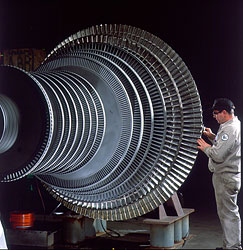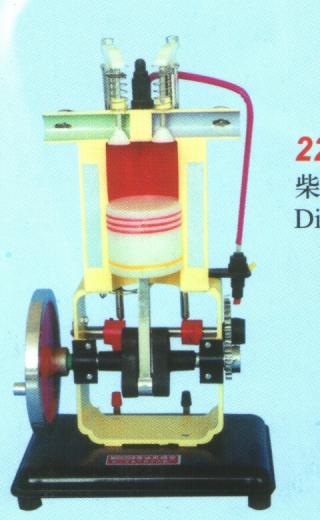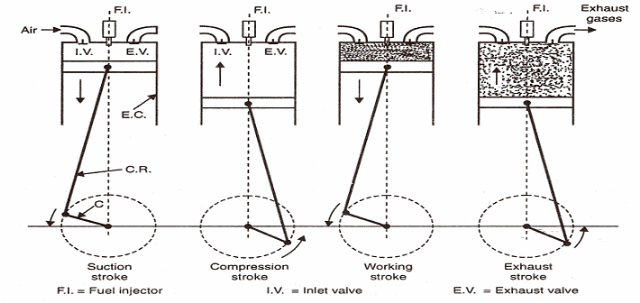Practical forms of heat engines
Mechanical work can be
transformed to heat in various ways. Heat can similarly be converted to
mechanical work by machines known as heat
engines. Heat engine is a mechanical
device by which heat can be converted to mechanical work. There are two
chief classes of heat engines in practical uses:
(1)
External combustion heat engine: In this type of engines the combustion of the fuel
takes place outside the engine proper. Steam-engine falls under this category.
(2)
Internal combustion heat engine: In this type of engines the combustion of the fuel
takes place inside the engine proper. Petrol engine, Diesel oil engine, etc.
fall under this category.
Condensing and non-condensing engines
 |
| Condensing engines |
 |
| non-condensing engines
|
In steam engine described
above, the spent steam is led to the atmosphere through the exhaust in puffs.
This type is known as non-condensing
engine. Locomotive engines are of this type. In some forms of engines, the
exhaust steam is condensed in a vacuum chamber, called condenser, where low temperature is maintained by a jet of cold
water. Marine engines are of this condensing type. These engines are somewhat
more efficient than the other type of engines. The condensed steam is put back
into the boiler.
Steam turbine
In steam engine the to-an-fro
motion of the piston is converted to rotatory motion by means of a crank and
rod. A piston comes to rest at the end of each stroke. This causes much shaking
and disagreeable vibrations.
Steam turbine is
fundamentally different from all types of steam engines in that the heat energy
present in the steam first used to set the steam itself in motion. The high
pressure steam comes out of boiler through a number of nozzles and strikes the curved blades on the rim of wheel. The
kinetic energy of the steam pushes the blades forward. The speed of the wheel
is enormous; sometimes the speed reaches 70,000 revolutions per minute if the
pressure of the steam from the boiler is reduced to atmospheric pressure in one
stage. So with the help of large reduction gears, the speed is lowered to the
desired value.
Advantage
In a turbine there is no
reciprocating motion and so it works smoothly without jerking. Moreover, it occupies
much less space. The efficiency of a turbine is much greater than that of a
steam engine. It is much less complicated than steam engine. Hence turbines are
used in steam ships, electric generating stations, etc.
Diesel engine
Diesel engines are
now-a-days considered as the most popular type of internal combustion engines.
Modern Diesel engines are widely used foe marine population, for heavy lorries
and buses, for generating electricity, driving factory machinery, pumping and
many other similar purposes. It is also in use in railway locomotives. In fact,
the steam engine is gradually becoming obsolete with the advent of high-power,
high-efficiency Diesel engine.
Operation
The whole operation of a
diesel engine may be divided into four strokes.
First stroke (suction-stroke)
During this stroke, the
exhaust and the fuel valves are closed, the air-inlet valve is opened and the
piston moves outwards. A charge of air is sucked in at nearly atmospheric
pressure.
Second stroke (compression-stroke)
During this stroke, all the
valves are closed and the piston is moving inwards. As a result, the air
previously sucked in is compressed to a high pressure of about 500 lbs. per
square inch.
Third stroke (working or power-stroke)
The air and exhaust-valves are closed and the fuel
valve is opened just before the beginning of this stroke and remains open
during a small part of the stroke. The high compression during the second
stroke raises the temperature of the air to about 1000°C which is above the
ignition point of the fuel (i.e. the temperature at which the fuel takes fire).
At this moment a small charge of fuel is forced into the combustion chamber.
Coming in contact with the heated air the fuel burns with great rapidity and
the subsequent expansion of the gaseous product imparts the necessary
power-stroke and the piston moves outwards. Towards the end of the power-stroke
the exhaust – valve opens and the spent gas in the cylinder begins to go out.
Forth
stroke (exhaust-stroke)
The air and the fuel valves are closed, the
exhaust-valve is opened and due to inward motion of the piston, spent gases escape
through the exhaust-pipe. The initial state is thus reached and the operation
is repeated.







No comments:
Post a Comment